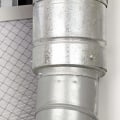COVID-19 is a contagious disease that is spread through contact with respiratory fluids that contain the SARS-CoV-2 virus. An infected person can be exposed to the virus by coughing or talking near them, or by inhaling aerosol particles that are released from the infected person. These particles can travel around an entire room or interior space, and can remain in the air for hours after the infected person has left. The virus can also be spread through contact with contaminated surfaces, although this is now considered to be less likely.
In a typical American home with a central air conditioning system, there is no option to use outdoor air. This can be dangerous in households where someone has the coronavirus or has been exposed to it. Reoccupying a building during the pandemic does not usually require new ventilation systems, but upgrades or improvements to the existing system can increase the supply of clean air and dilute potential contaminants. When considering changes to HVAC systems and equipment, it is important to consult experienced heating, ventilation and air conditioning (HVAC) professionals.
Buildings that provided healthy and code-compliant indoor air quality before the pandemic can be improved for pandemic occupancy through less costly interventions. There are several ventilation interventions that can help reduce the concentration of virus particles in the air, such as increasing ventilation rates, using high-efficiency filters, and using ultraviolet germicidal irradiation (UVGI). Implementing multiple tools at the same time is recommended for maximum effectiveness. The risk of contracting COVID-19 through drafts or air conditioning units is no more likely than through close contact or touching contaminated surfaces.
If someone in your household has tested positive for coronavirus infection, it is best to keep them in a separate room away from other people in the household. The layout and design of a building, as well as the occupancy and type of HVAC system, can affect the possible spread of the virus through the air. Public health experts have warned about airborne transmission of COVID-19 for months, as tiny exhaled particles (aerosols) can stay in the indoor air and travel longer than 6 feet. Opening a window can help bring in fresh air from outside and disperse stale air indoors, which could help reduce the possibility of spreading virus particles around the house.
In comparison, if you were outdoors and close to an infected person who exhaled some viral particles, there is a much larger volume of air that flows to disperse and dilute those particles quickly, reducing the risk of spreading to another person nearby. A central air conditioning system uses a fan to draw warm air from the room into a return vent, blowing it through coils that absorb heat and cool the air. Cold weather in winter similarly forces people to enter and increase heat, creating a poorly ventilated environment in which viral particles can spread through the air and cause infections. Scientists have done very little research on the role of HVAC systems in spreading coronavirus. If you haven't had a flow of people in and out of your home, then only droplets from you and anyone else in your house could spread through your air conditioner.






